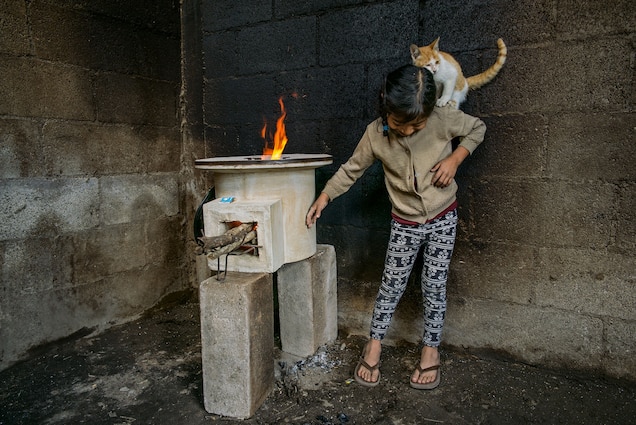Your kitchen fills up with smoke. Your immediate reactions are a) your meal is probably jeopardized and b) you should clear the air out before the smoke triggers the fire alarm. Although we regard smoke’s thick presence with agitation and a tad of disappointment, at least we have a signal that tells us that our cooking abilities are in need of revision. Millions of households in developing countries would actually be surprised if the air was clear while meal prepping.
The difference comes down to an appliance in virtually every kitchen: your stove. Electric and gas fuel produce heat instantly and at different degrees to one’s liking except for the nearly three billion people who instead depend on fires and inefficient cookstoves to feed themselves. Underdeveloped energy systems and constrained financial capabilities are a result of foundational political economy. Comparatively low economic measures project condition disparity amongst nations and global power distribution. Energy and development are evidently synonymous at the individual, national, and international levels. The poor’s dependence on inexpensive energy sources for survival consequently exposes two-fifths of the world to indoor air pollution that kills nearly 4 million people per year.
Tiny but considerable airborne particles produced by burning wood, agricultural wastes, and your own dung become concentrated, inhaled, and move within your lungs and bloodstream. Incomplete combustion is the materialization of inefficiency and the leading health hazard for developing nations. The probability of respiratory, heart, and fertility disease is enhanced for individuals who already frequently lack adequate health care and other essential services. The notion of a child smoking a pack of cigarettes a day is widely abhorred, yet exposure to traditional cookstoves produced equivalent effects. A 2020 study found children below five are at 30% higher risk of dying from indoor air pollution from traditional cookstoves across 14 countries in Sub-Saharan Africa. It should thus be alarming to nations and international organizations that 90% of all of Sub-Saharan Africa is reliant on non-commercial fuels. Indoor Smoke in Kenya alone is the culprit for 21,000 deaths annually. Worldwide it is responsible for the loss of four to five million children.
This health, economic, political, and social issue is also of substantial environmental concern. Incomplete biofuel combustion is a driver of forest degradation, loss of habitat and biodiversity, and global warming. Burning wood and other solid fuels for cooking contribute a gigaton of CO2 and methane emissions roughly equal to that of the aviation industry. Also released are black carbon aerosols that are up to 1500 times more potent than CO2. These are carried by strong winds to poles and high-altitude, mountainous regions and make glacial ice melt faster because they absorb sunlight and trap heat in the lower atmosphere. 25% of black carbon emissions come from burning charcoal or wood for cooking purposes. The scale of the toxic and burdensome impact of inefficient cooking in the underdeveloped world is of global concern.
Women and children feel disproportionate economic and health burdens since these groups spend the most time around the stove and collecting biomass for fuel. Women are also the primary fuel purchasers, while only in control of a minor share of family income. A study found traditional stoves can take four hours to cook and women can spend up to 20 hours a week collecting materials. This time burden prevents women from engaging in income-earning and is increasing with deforestation and soil degradation. It is a bitter irony that spending time collecting wood or making charcoal in order to feed yourself impairs your very purpose of survival.
Abundant data indisputably informs that technology accessibility increases your lifespan and quality of life. Disproportionate distribution of domestic responsibilities in conjunction with lacking energy alternatives perpetuates the vicious cycle of gendered and environmental inequality. And, early cookstove training courses were at times only offered to men even when cooking duties in developing nations are performed by women 90% of the time. Feminism and discrepancies between the developed and the developing are thus embedded in the deadly cookstove.
Unsuccessful technology development attempts are present in virtually every developing nation, and the progress of cookstove programs is no exception. The preponderant Western influence in science, politics, and the economy initially debilitated the potential of “improved cookstove” initiatives. Patronizing patterns wasted time and funding until sources of input were broadened. Local and cultural knowledge commonly deemed as “mundane science” and obstacles of affordability and user preference became more of a prerogative in supplement to standardized science and approaches.
UC Professor of Energy Daniel Kammen has published and co-published journals encompassing such evolution in efficient and pro-health cooking initiatives. Professor Kammen emphasized understanding how people interact with their appliances when interviewed on the topic. He too advocates that “person-to-person connection” and strong consideration of gender issues are essential after working on cookstove projects with local community leaders and experts alike for three decades. The story of the Kenya ceramic Jiko in his piece Cookstoves for the Developing World is one such suitable representation of the enlightening impact ensuing when those directly plagued contribute.
Jiko, meaning “stove” in Swahili, delivers 25% to 40% of the heat from a fire to a cooking pot and is now used in nearly a million households in East Africa. Hundreds of millions of households use its predecessor, the traditional metal stove, but it yields only 10% to 20% efficiency. An open cooking fire delivers as little as 10%. The early initiative prototypes were, unsurprisingly, impaired by Eurocentrism and inadequate stove physics and engineering design.
Improvement was actualized with input from growing scientific academia and notably from female organizations centered around the issues of community and environmental protection. They mirrored the feminist movement spreading throughout the developing world. It was women in Kenya who suggested remodeling the metal bucket design into an hourglass shape. This prevented both the prior threat of the stove tipping over and cracking from overheating. Training programs organized by aid groups and women’s organizations nurtured the acceptance of more efficient stoves. Fundamental redirecting in both design and strategy began to change the direction of the narrative. Real progress was now developing.
The loose consortium of Kenyan craftspeople known as Jua Kali, or “hot sun,” began to manufacture and sell approximately 20,000 stoves a month. 1,300 pounds of fuel, or about $65, are now being saved per household. These savings can be up to a fifth of an urban dweller’s income and are frequently instead invested into small businesses or education fees. Decreased fuel frequency and smoke emissions also promoted cleaner living environments and forest conservation. Further improvements in sustainable and clean energy innovations remain imperative. Multiple populations ranging in financial capabilities, education, geography, traditions, and culture require personalized quantifying processes in order to formulate flexible implementation measures for a variety of energy issues. These multifaceted efforts must especially prioritize affordability, accessibility, and convenience. Stimulation of progress is at least increasingly associated with these adjustment factors exemplified in Jiko. Inclusive and customized procedures rather than standardized procedures make all the difference.
Government and international efforts for clean cooking can only succeed if guided by the essence of the women and households who face this menace daily, and if the efforts are cooperative with and empathetic to social and political constraints. Incentives and initiatives guided by these principles at the global level have the potential to simultaneously target greenhouse gas emission reductions, equitable technology distribution, and global health. Pro-health, efficient cookstoves and human development need not be a zero-sum game against the environment. It would in fact be discriminatory to discourage developing nations from taking the energy infrastructure paths taken by the wealthy due to the notion of sustainability. This shallow, Eurocentric notion generalizes a significant complex issue that worries environmentalists, economists, governments, development theorists, and other field experts alike. Interdisciplinary collaboration and global development prove to be the true remedies, not just against the deadly cookstove, but also for what it stands for.
As Professor Kammen said, the problem would have never been understood if we did not look hard and dig up the things we take for granted. Scrutinizing the kitchen to an extreme degree revealed important global and societal vices that would have otherwise remained commonly concealed and destructive. So what magnitude do other appliances around you possess, and what difference do they make to your quality of life?
Featured Image Source: National Geographic






Comments are closed.